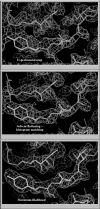Maximum-likelihood density modification
- PMID: 10944333
- PMCID: PMC2792768
- DOI: 10.1107/s0907444900005072
Maximum-likelihood density modification
Abstract
A likelihood-based approach to density modification is developed that can be applied to a wide variety of cases where some information about the electron density at various points in the unit cell is available. The key to the approach consists of developing likelihood functions that represent the probability that a particular value of electron density is consistent with prior expectations for the electron density at that point in the unit cell. These likelihood functions are then combined with likelihood functions based on experimental observations and with others containing any prior knowledge about structure factors to form a combined likelihood function for each structure factor. A simple and general approach to maximizing the combined likelihood function is developed. It is found that this likelihood-based approach yields greater phase improvement in model and real test cases than either conventional solvent flattening and histogram matching or a recent reciprocal-space solvent-flattening procedure [Terwilliger (1999), Acta Cryst. D55, 1863-1871].
Figures

References
-
- Abrahams, J. P. (1997). Acta Cryst. D53, 371–376. - PubMed
-
- American Type Culture Collection (1992). Catalogue of Bacteria and Bacteriophages, 18th ed., pp. 271–272.
-
- Bricogne, G. (1984). Acta Cryst. A40, 410–445.
-
- Bricogne, G. (1988). Acta Cryst. A44, 517–545.
-
- Cowtan, K. D. & Main, P. (1993). Acta Cryst. D49, 148–157 - PubMed
MeSH terms
Substances
LinkOut - more resources
Full Text Sources
Other Literature Sources

